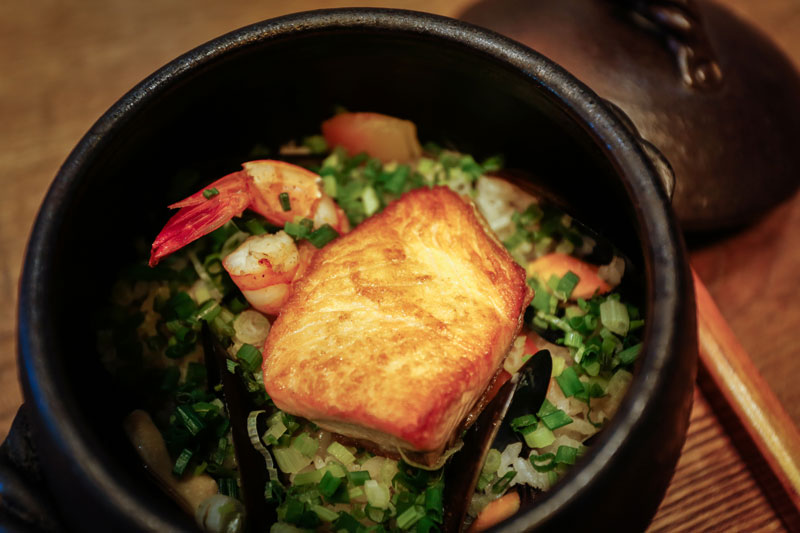Chef Yasuda Daiki named his Phnom Penh restaurant Dashi after what he considers the fundamental component of Japanese cuisine.
“The most important element of Japanese food, the basis of the cuisine, is dashi,” he said.
Made by heating kombu, or dried kelp, and thinly shaved dried flakes of bonito fish in hot water, dashi is used instead of water to cook rice at the restaurant. At Dashi, Mr. Daiki prepares the broth himself every day.

Dashi is also key to the preparation of “kamameshi paella,” the chef’s take on the Spanish rice dish paella.
He starts by cooking rice, prawns, mussels, cherry tomatoes, anchovies and butter under a layer of dashi directly over an open flame in a covered earthenware bowl.
Once the liquid has been absorbed, Mr. Daiki opens the bowl to sprinkle green onions over the dish, and adds a piece of lightly grilled salmon. He then puts the cover back on the bowl for a few minutes so the salmon can finish cooking in the dashi steam. The bowl is opened in front of the guest, letting out a cloud of steam and an aroma of seafood. The dish is served with a side of dashi in a small sauce pot so the diner can add extra broth if he prefers a more soupy consistency.
Born in Akita City in northwestern Japan in 1977, Mr. Daiki moved to Tokyo in his early 20s to work as an apprentice chef in the kaiseki tradition. Considered the haute cuisine of Japan, kaiseki is a multi-course meal comprising a succession of complex and delicate dishes. In his training, Mr. Daiki cut vegetables for a year, then moved on to appetizers, soups, and eventually main courses and sashimi, he said.
“It took me more than five years before I was allowed to prepare sashimi,” Mr. Daiki explained. He spent that time preparing vegetables or rice for sushi before he was finally granted the privilege of cutting raw fish into pieces.
The chef relocated to Phnom Penh from Tokyo two years ago to work at a restaurant in a Japanese-owned residential building. After a year in Cambodia, Mr. Daiki and his wife, Shin Yun-hee, who worked in the hotel industry in Tokyo, decided to open their own restaurant. It is designed in a contemporary style, with an open dining area and a sashimi bar. The restaurant employs an all-Cambodian staff, including cooks that Mr. Daiki trains himself.
Getting the high-quality fish necessary for Japanese cuisine has taken some planning. While white fish can be obtained in Sihanoukville, salmon and tuna must come from abroad. So every two weeks, Mr. Daiki makes a one-day trip to Bangkok to personally select the fish from a Japanese restaurant supplier.
But on most days, Mr. Daiki, with his rather shy demeanor, can be found calmly minding the sashimi counter and, of course, making dashi.